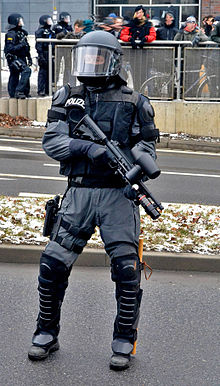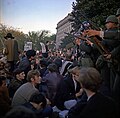Riot control
Riot control measures are used by
If a riot is spontaneous and irrational, actions which cause people to stop and think for a moment (e.g. loud noises or issuing instructions in a calm tone) can be enough to stop it. However, these methods usually fail when there is severe anger with a legitimate cause, or the riot was planned or organized. Riot control personnel have long used
There have been cases where lethal weapons are used to violently suppress a protest or riot, as in the
History

Maintaining order during demonstrations and quenching riots has always been a challenge for governments and administrations. Until early in the 20th century, no dedicated force really existed in most countries and the traditional response when the regular police force proved inadequate was to call upon the army, often with disastrous results: either fraternization or use of excessive violence.
The terminology arguably first arises in the Keystone Cops short "A Hash House Fraud" in 1915.[1]
In France, for example, several revolts were fueled by poor handling by the military. The National Gendarmerie created specialized "mobile" gendarmerie forces several times during the 19th century in times of trouble but these units were disbanded soon after the end of the troubles they had been tasked to handle and there was no permanent organization in place until it was finally decided in 1921 to create "Mobile Gendarmerie platoons" within the Departmental Gendarmerie. These platoons, either horse mounted or on foot were composed of 40 gendarmes each (60 in the Paris Region). In 1926, the platoons formed the "Garde Républicaine mobile" (mobile republican guard or GRM), which became a distinct branch of the Gendarmerie in 1927, the platoons becoming part of companies and legions. By 1940, the GRM was a force 21,000 strong, composed of 14 Légions, 54 company groups and 167 companies.[2]
Long the only large force specialized in maintaining or restoring law and order in France during demonstrations or riots, the GRM progressively developed the doctrine and skills needed in that role: exercise restraint, avoid confrontation as long as possible, always leave an "exit door" for the crowd, etc.[3] In 1940, after the fall of France, the German authorities had the GRM disbanded but it was reinstated in 1944 and renamed Mobile Gendarmerie in 1954.[4]

The first squad trained in modern techniques of riot control in Asia was formed in 1925 in colonial Shanghai as a response to the mismanaged riot of the May Thirtieth Movement.
New policing methods, including
Under Fairbairn, the SMP developed a myriad of riot control measures. These riot control techniques led to the introduction of Shanghai's "Reserve Unit", used to forcibly disband riots and respond to high-level crimes such as
Equipment

For protection, officers that are trained in police anti-riot schools performing riot control will often wear protective helmets and carry riot shields. These are designed to protect the wearer from those dangers that come from direct melee and hurled objects such as bottles and bricks. The gear frequently worn by riot control officers protects the entire body with no vulnerable spots to exploit. For example, the helmets worn by riot control officers have an additional outward-extending part that protects the back of the neck from assault. To provide even greater protection, the protective equipment often provides ballistic protection. If tear gas or other riot control agents are to be used, gas masks may also be worn.
One of many additional concerns is to prevent people in the crowd from snatching officers'
The initial choice of
Special riot hand weapons include the
In major unrest, police in armoured vehicles may be sent in following an initial subduing with firepower. Occasionally, police dogs, fire hoses, or mounted police are deployed.
-
French gendarmes mobilesusing tear gas
-
This gendarme is shooting tear gas canisters using an Alsetex "Cougar" launcher
-
Syrian riot control in Damascus in 2012
-
Polish riot control police in Warsaw at the March of Independence in 2011
-
Defensive line ofriot gear by the Cabinet of Ministers building in Kyiv during 2013 Euromaidanprotests.
-
Riot control group of Rio de Janeiro Police in confrontation with protesters in the historical center of the city.
-
Italian Celerini in the 1950s.
-
Pellet shotguns have been used by Indian security forces for crowd control in Jammu and Kashmir against stone pelting mobs.
-
Intervention vehicle for social events that interfered with demonstrators inGezi Park (Istanbul) in 2013
Riot control agent (RCA)
Riot control agents (sometimes called RCAs) are
Pepper spray

The active ingredient in pepper-spray is
Pepper spray typically comes in canisters, which are often small enough to be carried or
Tear gas
While the use of tear gas in warfare is prohibited by various international treaties[NB 1] that most countries have signed, use by police and for private self-defense is not banned in an international manner.
Popular tear gases include the eye irritants
Decontamination
At room temperature, tear gases are white solids. They are stable when heated and have low
Decontamination of material after contamination with CR gas is not possible for up to 45 days. CS can be decontaminated l with a 5–10 percent soda solution or 2 percent alkaline solution. If this type of decontamination cannot be accomplished (e.g., contaminated rooms and furniture), then the only other means is by intensive air exchange—preferably with hot air. Exposed streets and sidewalks will have toxic and irritating CS powder that will be stirred into the air by traffic and pedestrians long after the cloud has dissipated, and should be washed away with water. In contrast to human beings, domesticated animals generally have lower sensitivity to tear gases. Dogs and horses can therefore be used by police for riot control even when tear gas is used.[citation needed]
Dispensing large quantities
Backpack dispensers for riot control agents, when the intent is to use a larger quantity than possible with grenades, are one type of device used by organizations that might, for example, need to cover a prison yard.
Tactics

The front-line officers in a riot control are often fully armored and carry weapons such as batons, designed to be in direct contact with the crowd. These officers subdue rioters and subsequently allow the less heavily armoured, more mobile officers to make arrests where it is deemed necessary. In face of a greater threat, the riot police will be backed up with other officers equipped with
As a less aggressive step, mounted police may first be sent into the crowd. The might and height offered by the horse are combined with its training, allowing an officer to more safely infiltrate a crowd. Usually, when front-facing a riot, officers slowly walk in a line parallel to the riot's front, extending to both its ends, as they noisily and simultaneously march and beat their shields with their batons, to cause fear and psychological effects on the crowd.

In the United Kingdom, usually when large demonstrations take place that are deemed unstable, the
A more straightforward tactic police may use is a baton charge which involves police officers charging at a crowd of people with batons and in some cases, riot shields. They run at the crowd hitting people with their batons, and in some situations use riot shields to push them away. Baton charging is designed to cause the maximum amount of pain, in the hope that they would be compelled to move away from the scene, dispersing the crowd.
Research
Research into weapons that are more effective for riot control continues. Netguns are non-lethal weapons designed to fire a net which entangles the target. Netguns have a long history of being used to capture wildlife, without injury, for research purposes. A netgun is currently in development for non-lethal riot control. Pepper-spray projectile launchers are projectile weapons that launch a fragile ball which breaks upon impact and releases an irritant powder called PAVA (capsaicin II) pepper. The launchers are often slightly modified .68 caliber paintball guns.
See also
- Demoralization (warfare) – Warfare tactic used to erode morale
- Free speech zone – Area set aside in public places for the purpose of political protesting
- Personal armor– Protective clothing; armor worn on the body
- Blunt trauma personal protective equipment – gear that protects the wearer against injuries caused by blunt impacts
- Baton charge – Police tactic for crowd dispersion
- Crowd control – Public security practice
- Crowd manipulation – Application of crowd psychology
- Crowd crush– Type of disaster that occurs due to overcrowding
- Non-military armored vehicle– Armored vehicle operated outside military organizations
- Kettling – Police tactic of containing people at a protest
- Snatch squad – Tactics used by police in riot control
Riot control units
- Garda Public Order Unit (Ireland)
- Units for the Reinstatement of Order (Greece)
- Rapid Action Force (India)
- Mobile Brigade Corps(Indonesia)
- Compagnies Républicaines de Sécurité (France)
- Mobile Gendarmerie (France)
- Police Tactical Unit (Hong Kong)
- Special Tactical Squad(Hong Kong)
- Territorial Support Group (London in England)
- Carabinieri Mobile Units Division (Italy)
- Mobile Unit (Italy)
- Unidades de Intervención Policial (Spain)
Weapons used in riot control
- Non-lethal weapon
- CS gas
- Long Range Acoustic Device
- Plastic bullets
- Pepper spray
- Rubber bullet
- Water cannon
- Pellet guns (pellet shotguns)
- Use of bayonets for crowd control
Notes
- ^ e.g. the Geneva Protocol of 1925: 'Prohibited the use of "asphyxiating gas, or any other kind of gas, liquids, substances or similar materials"'
References
- ^ A Hash House Haul 1915
- .
- ISBN 978-2724606768.
- ^ Histoire de la Gendarmerie mobile d'Île-de-France [History of the Île-de-France Mobile Gendarmerie] (in French). Spe Barthelemy Eds. 24 November 2006.
- ^ Vortisch, Hans-Christian (10 January 2008). Masters, Phil (ed.). "GURPS Martial Arts: Fairbairn Close Combat Training" (PDF). Steve Jackson Games.
- ^ 3.1 Manufacturers | the Thermal Fogger.
- ^ "Article II. Definitions and Criteria". OPCW. Organisation for the Prohibition of Chemical Weapons. Retrieved 31 March 2018.
- ^ "CS Gas". h2g2, The Hitchhiker's Guide to the Galaxy: Earth Edition. British Broadcasting Corporation. 19 April 2011. Retrieved 26 December 2008.
- from the original on 24 October 2002.
- ^ U.S. Army Chemical and Biological Defense Command (CBDCOM) (June 1998), Commercial Backpack Blower/Sprayer System (PDF), archived from the original (PDF) on 28 July 2004
- ^ "FM 19-15 CHPTR 9 Riot Control Agents".
- ^ "Operation TAILWIND Review: Extract of U.S Air Force Report". Air Force Historical Office. 16 July 1998. Archived from the original on April 20, 2009.
- ^ "Experimental Riot Control: Riot Foam". How It Works Magazine. How It Works. August 2011.
External links
 Media related to Riot control at Wikimedia Commons
Media related to Riot control at Wikimedia Commons










